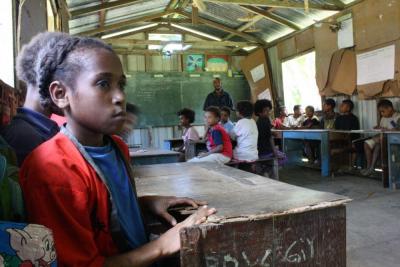By Scott Waide

But like many schools through out Papua New Guinea the fibro classrooms show the wear and tear of the generations of kids who came through this school.
Like many others, I was just passing through to get to a vintage point where I could get a few take still photographs of Madang town in the far off distance. Walking into a classroom, a met a teacher. I asked If it was alright if I took a few pictures of the school and the children.
Nobnob primary doesn’t have the luxury of brand new classrooms but it does have a well maintained playing field and a tiny library . I guess, that’s what’s really important to kids – being able to play and enjoy growing up and being able to learn. Then again you think to yourself: how many of our political leaders would choose to send their children to schools like the Nobnob primary school? I can’t answer that for you.
[img_assist|nid=2804|title=|desc=|link=none|align=left|width=225|height=150]Some of the children, wide eyed and curious clutching worn copies of oxford dictionaries stared as I shot off a few stills on the camera I took with me. I wanted to tell a story. But what story?
I’d seen this story repeated a hundred times before. What new story was I going to tell?
A sob story about children not achieving their dreams because government subsidies weren’t always paid on time? About demoralized teachers struggling without pay and in poor living conditions as the cost of goods continued to rise everyday? About the teacher trying to decide whether he should have his salary deposited into his bank account only to have ridiculous bank fees charged on his earnings?
Lecturers in university would have said give the story a human face, Scott. Make people see that it’s not just about the lovely statistics on flashy Power Point presentations. The kind that aid donors and government officials love to talk about in air conditioned conference rooms in Port Moresby.
[img_assist|nid=2805|title=|desc=|link=none|align=left|width=225|height=150]Yes. But what story? The two other teachers I spoke to said Nobnob Primary is supposed to get 20 thousand kina every quarter as school subsidies. But it’s not news any more that the money doesn’t arrive on time or that many times it does not arrive at all. It’s not surprising. Not shocking anymore that our kids aren’t getting the support they need to achieve their dreams.
It doesn’t bother us anymore that maybe the kid in the picture I took won’t become a doctor because next year he’ll have to stay home all because daddy’s busy raising money to send his older brother to high school.
What story should I tell?
For all this has become a monotonous repetition of stories with human faces we all recognize and live with everyday and yet choose to ignore. But then again, Nobnob is fortunate to have teachers and classrooms and a road leading to Madang town.
What about that school in Fiak? I bet you never heard of tiny primary school in some “insignificant” corner of the Sandaun province represented only by a mere statistic in the air conditioned conference rooms in Port Moresby. It’s a school that has had chronic teacher shortages for the last decade. Teachers just don’t want to go there anymore because the planes don’t fly there anymore because it’s unprofitable.
So what story should I tell?
- rait man's blog
- Log in to post comments
